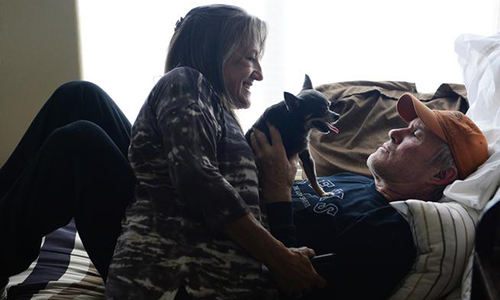Legacy Stories
Greg Ploetz

Greg Ploetz was an undersized but tenacious lineman for the University of Texas. While at UT, Ploetz was part of the 1969 National Championship team, was a two-time All Southwest Conference Team member and was selected as a 2nd Team All-American. After college, Ploetz became a college and high school art teacher for 40 years. He began suffering from dementia and neurologists diagnosed him with Alzheimer’s Disease. After his death at the age of 66, Ploetz was diagnosed at the VA-BU-CLF Brain Bank with stage 4 (of 4) Chronic Traumatic Encephalopathy (CTE). His family shared his story in order to provide comfort to others suffering from symptoms of CTE and their families.
By Deb Ploetz
Gregory Paul Ploetz was a Renaissance Man. He was brilliant, clever, and could do most anything. He was not only a gifted teacher and artist, an educated speaker, but he could also change the oil in his car and plumb and wire an entire house.


His success as an athlete was proven by his participation on the 1969 University of Texas National Championship Team. He was a formidable Defensive Tackle and was elected to the All Southwest Conference team twice and 2nd team All-American. Unfortunately, this success caused him to suffer and die from Stage Four CTE after battling the disease for more than ten years. He had no other health issues.
Greg and I were married for 37 years after only dating for five months. It was love/like after the first date. He had his Masters of Fine Arts from the University of Texas and used his talent for sharing his knowledge of art through teaching at the college and high school levels for forty years. He was also a committed and loving father of our two children. We were going to spend our golden years owning and living in an art space/gallery in San Antonio, TX near his family. CTE robbed Greg of fulfilling his dream.

In 2009/2010 the neurological community did not feel comfortable calling it CTE before death and three neurologists kept telling us it was Alzheimer’s. CTE causes dementia, thus, it is the only dementia that is preventable. For Greg, using medical marijuana the last two years of his life helped diminish his suffering and gave him some peace of mind. In 2014, we moved to Colorado, and got him a license to use the oil. I stopped all of his prescribed behavioral drugs and used MMJ.
If he knew he was going to die from this disease, I think he would have chosen not to play. He ended up loving art over football. During his art career he was mostly an abstract painter, but in 2010, with full blown dementia, he tried to execute the realist art form in a naïve football painting. It was one of his last attempts to make art.

Like others that have lost a loved one, my grief and pain is with me every day. It gives me comfort to share his art and journey. He has a very important legacy and story to tell.
Greg's niece, Meg Dudley, directed and produced a short film, "Art of Darkness: A Story of CTE," capturing his decline and its effect on his family. View the film below.
Greg’s work was featured in an art exhibit at Fort Works Art in Fort Worth, TX in September 2017. A portion of the proceeds benefitted the Concussion Legacy Foundation.
You May Also Like

Living with suspected CTE can be difficult, but CTE is not a death sentence and it is important to maintain hope. Find out how.
Living with CTE
Although we cannot yet accurately diagnose CTE in living people, a specialist can help treat the symptoms presenting the most challenges.
CTE Treatments